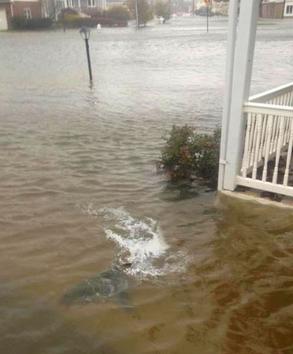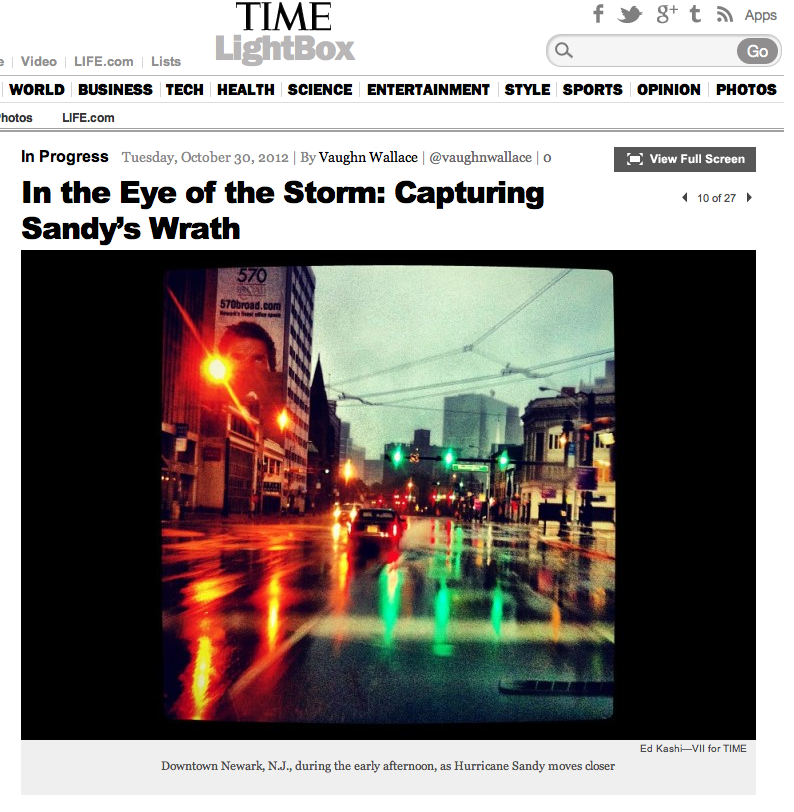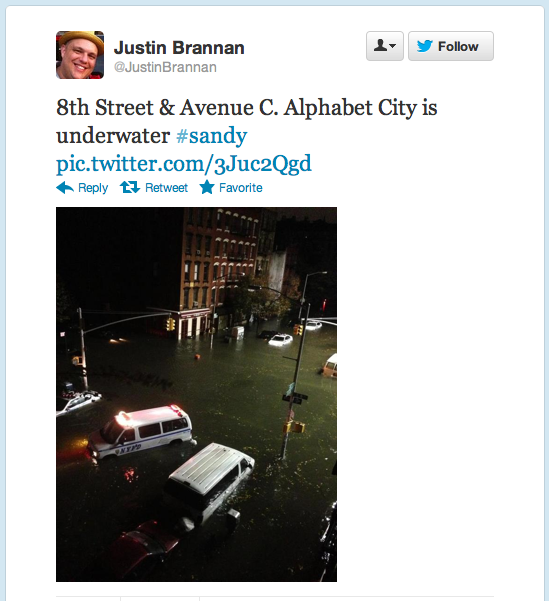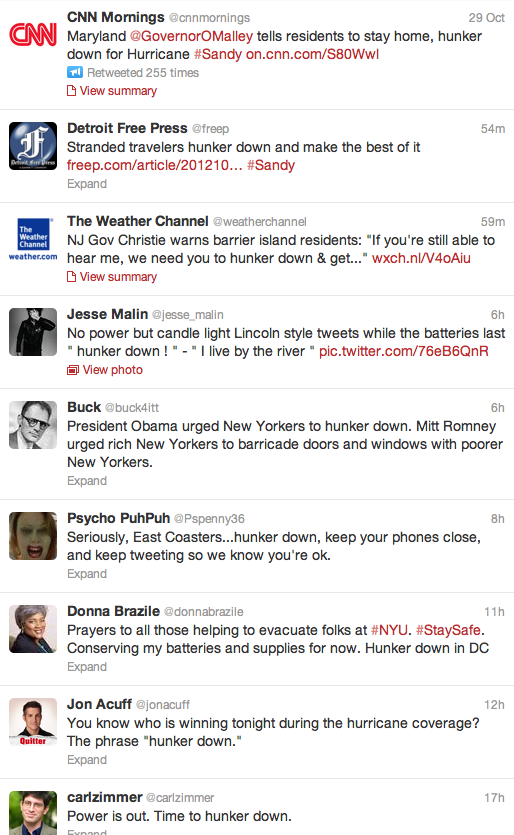The Hurricane Sandy storylines are still unfolding, but one thing became clear on Monday as winds and water overtook New York City and New Jersey in historic proportions: Digital media deepened the transformation of the disaster narrative. Here’s some of what’s out there today in various storytelling forms:
The New York Times’ Tumblr-like live update stream was the cleanest and easiest to follow: vignettes and bulletins textured with photos, Q-and-A’s, video and tweets. This kind of color and ticktock used to feed the big day-after or Sunday 1A read. But live field reports, presented discretely, make it it easier for the reader to choose her own story thread and decide what’s essential – city closings or a daybreak report from the beaches of Montauk? Yet it all holds together as a narrative timeline. The Times also ran a terrific interactive damage graphic featuring specifics on power failures, flooding, wind and subways/railroads, alongside maps and readers’ tweets and photos. Altogether this kind of information documents data/context and lays a foundation, making the Big Narrative easier to report and write.
The storm happened to hit the most media-centric city on earth, one that’s particularly obsessed with social media, which generated some strong source material. (How diverse was it? Still waiting to see.) Instagram users were posting 10 #Sandy photos per second, Gizmodo reported. TIME magazine had five photographers shoot the storm via Instagram and ran it as a photo essay:
And the Wall Street Journal compiled the most-shared photos and tweets, including this one from Brooklynite Justin Brannan:
Great narrative requires compelling characters, and we’ll see those emerge in the aftermath: the rescue workers, the cleanup crews, the hospital employees who evacuated patients when generators failed. It got a little ridiculous, hearing Mayor Bloomberg’s sign language interpreter, Lydia Callis, called the “breakout star” of Sandy, but that’s what happened as the storm blew in, enough so that she earned tribute gifs and at least one Tumblr fan page.
And of course there had to be a villain. The Twitterverse backslapped BuzzFeed’s Jack Stuef this morning for outing a hedge fund analyst as a fabulist. From Stuef’s story:
During the storm last night, user @comfortablysmug was the source of a load of frightening but false information about conditions in New York City that spread wildly on Twitter and onto news broadcasts before ConEd, the MTA, and Wall Street sources had to take time out of the crisis situation to refute them.
 Inevitably, a fake shark showed up. Journalists spent a chunk of the night figuring out which photos were real, and doing damage control on those going viral – the underwater carousel, the flood reports at the New York Stock Exchange, the ominous cloud and towering waves at the Statue of Liberty. The Atlantic’s Alexis Madrigal and his team compiled a post tagging image after image as bogus, legit or unverified. He wrote:
Inevitably, a fake shark showed up. Journalists spent a chunk of the night figuring out which photos were real, and doing damage control on those going viral – the underwater carousel, the flood reports at the New York Stock Exchange, the ominous cloud and towering waves at the Statue of Liberty. The Atlantic’s Alexis Madrigal and his team compiled a post tagging image after image as bogus, legit or unverified. He wrote:
This post, which will be updated over the next couple of days, is an effort to sort the real from the unreal. It’s a photograph verification service, you might say, or a pictorial investigation bureau. If you see a picture that looks fishy, send it to me at alexis.madrigal[at]gmail.com. If you like this sort of thing, you should also visit istwitterwrong.tumblr.com, which is just cataloging the fakes. The fakes come in three varieties: 1) Real photos that were taken long ago, but that pranksters reintroduce as images of Sandy, 2) Photoshopped images that are straight up fake, and 3) The combination of the first two: old, Photoshopped pictures being trotted out again.
Journalists, along with the authorities, also spent a lot of time weeding fake viral news reports from the verified narrative of the day.
“Hunker,” meanwhile, became the most overused word of, like, ever, and should never appear in storm coverage again:
The drama wasn’t confined to land. The HMS Bounty, a replica three-masted ship built for the 1962 film Mutiny on the Bounty, sank off the coast of North Carolina, killing two. The Washington Post’s Ian Shapira wrote a breaking narrative of the disaster. His lede:
The tall ship began to die early Monday morning in the hurricane-ravaged waters off the North Carolina coast. One of the HMS Bounty’s generators failed. Water flooded everywhere. The 180-foot-long, three-masted tall ship was losing power and propulsion.
By about 3 a.m., the Bounty’s once-optimistic Facebook page, which on Sunday had posted “So far so good!” in its daily updates, had issued a new message for its followers: “Your Prayers are needed.”
The Tampa Bay Times’ Marissa Lang told a slice of the story through the eyes of the ship’s retired captain:
“I was very fortunate to have had this ship as such a part of my life,” Boyd said. “We had some good times together. (The Bounty) took care of me.”
As he speaks, his eyes linger for an instant on the signatures around a poster of the ship. The poster is framed, hanging on a wall filled with images of the three-mast tall vessel: oil paintings, photographs, models, sailor’s knots of rope.
In the next room are boxes full of Bounty memorabilia: ship stationery, maps, rigger bags, a bunk bed, lamps.
Roy Boutilier, 71, who sailed with Boyd on the vessel’s first voyage to Tahiti during the filming of Mutiny on the Bounty, gestured to the wall.
“It becomes a huge part of you,” Boutilier said. “I still meet people who will say, ‘You’re the guy who sailed on the Bounty.’ It’s kind of incredible; she’s everyone’s ship.”
And Robin Beth Schaer, a New York writer and former Bounty crew member, soon came along with a short, lovely Paris Review essay. An excerpt:
I want to look away from the broken ship with her masts snapped and hull submerged. I want to blur the crew lifted by helicopters from twenty foot seas. I want to veer from the Captain, washed overboard, and drifting alone in rough waters. I say the truth is unfathomable and the phrase snags in my throat, a trope already taken from the sea. I catch myself saying fathom again: a word that once meant embrace, and then the length from arm to arm of rope or water, and now means understanding. Bounty is on the sea floor and her Captain lost (my ship, my Captain gone); I don’t want to hold, or measure the depth, or understand this loss.
Other kinds of surprises emerged, such as a tangential spat over a “newsjacking” blog post from marketers, featuring ill-conceived tips on how to spin Sandy for profit. Of the HubSpot post, best-selling author and marketing strategist David Meerman Scott wrote:
According to early news reports (I’m writing this early in the morning after the storm hit), Hurricane Sandy has caused $20 billion in economic damage and at least 15 people have lost their lives. A million people have been under orders to evacuate their homes and 7 million people are without power.
This is not the sort of story to promote cosmetics and fashion, two ideas on the HubSpot post.
These sorts of frivolous newsjacking ideas give the concept of newsjacking (and marketers in general) a bad name because it is a blatant attempt to exploit a tragedy.
(HubSpot apologized and announced plans to donate $5,000 to the Red Cross.)
In the middle of all this, moments of literary grace. The New Yorker’s Mary Norris filed a short, lovely narrative of a pre-Sandy boat ride across Jamaica Bay. An excerpt:
Soon I had to take my friend back to her house on the water. I called the boss at the marina, to let him know I’d be a little late—closer to five-thirty. The return trip was faster: now I was going with the tide. Four swans flew over, their necks stretched out like those trumpets they use in productions of Shakespeare to blow a fanfare for the king.
If you know of a great Sandy narrative or interesting narrative-related coverage, let us know and we’ll give it a mention.






